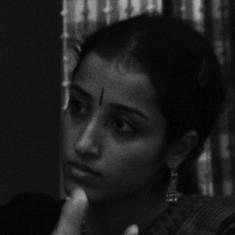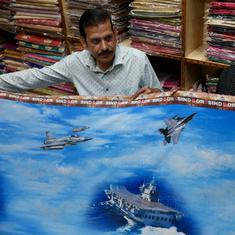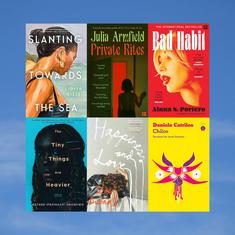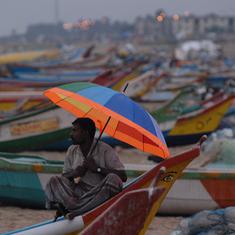The Djinn Waits A Hundred Years is the latest offering from South African writer Shubnum Khan, whose previous works include Onion Tears, shortlisted for the Penguin Prize for African Writing, and How I Accidentally Became A Global Stock Photo, a charming collection of essays that was available in India as well as South Africa. Her international debut, The Djinn, arrives with all guns blazing, combining elements of history, magical realism, and cultural exploration, and delving into the themes of love, longing, loss, identity, belonging and loneliness.
Set against the backdrop of a charming old mansion called Akbar Manzil, in Khan’s hometown Durban, the novel unfolds to reveal a captivating narrative that spans a century and is told mostly through the eyes of the protagonist, 15-year-old Sana, who’s been brought to this city by the sea by her father, Bilal, after her mother’s passing. They are to take up residence inside the dilapidated mansion under the stewardship of the landlord, Doctor. It is within these walls that the title’s Djinn has been waiting.
Personal and chronological past
The book is set in dual timelines – one belonging to Sana as she attempts to discover the history of her new home while battling the burdens of her own past, including the ghost of her dead sister, and the other set in the actual past, revealing to us the stories of the original residents of the once grand and opulent castle-like residence of a man named Akbar Ali Khan. We are also introduced to its current inhabitants, “who come to Akbar Manzil to forget or be forgotten”.
From grumpy old ladies to piano players in high-up rooms, a talking bird, and a cleaner who doesn’t clean, they’re a cast of diverse characters, and Khan has worked hard to give the readers their personal histories. Together they paint a vivid picture of human life and its myriad foibles. They provide comedy and colour to a book that even Khan know could not hold its own on the shoulders of its quiet protagonist Sana alone. The most well-drawn character though, by far, is the house itself, Akbar Manzil.
The house shares a name with Akbar, our hero who found his spot in the world in the 1920s in Durban, leaving behind an India readying for the freedom movement. On new shores, he builds a home that is an eclectic mix of an abode – “a Georgian manor with whispers of domes, Gothic towers, Islamic arches, and European balconies, which when rises on the hill, the townspeople below shake their heads in disbelief”. It mirrors its maker in many ways – an Indian immigrant, with a persistent curiosity and a great love of adventure and the world. Akbar, it quickly becomes apparent, is also shielded by the vicissitudes of fate due to his wealthy background and will be torn apart by what destiny has in store for him. As a character, he is a captivating man, but readers will be divided into those who swoon for him, and those who find him blissfully ignorant, whimsical, and self-centered.
The cast of Akbar’s world – his wife, the Eurocentric Jahanara; his mother, the stereotyped mother and mother-in-law figure, “Ammi”, and his two children paint a near picture-perfect portrait of a satisfied if not happy family. The fragile picture is marred for everyone but him by the arrival of Meena, his second wife. Painted as a woman who has broken free of the cultural shackles of her times, Meena is independent, stubborn, humble, and unconventionally beautiful. From her dark skin to her unkempt hair, she is from the start presented as a muse, a poet’s love.
What is love?
This is also where the book truly shines, in its beautiful portrayal of the love story between Akbar and Meena. The sonnets exchanged between the two, Meena's recounting of them in her journal, and the vivid imagery of the scenes they inhabit all stand as testimony to the real star of the book: Love.
Meena’s writings are filled with “definitions, poetry, and excerpts of conversations,” and you yearn to know more about her and their mad romance. In this, the reader and the protagonist Sana are united, because love is also a concept young Sana wants desperately to comprehend. In her encounters with the current residents of Akbar Manzil, Sana seeks to understand the enigmatic essence of love – a quest met with diverse interpretations and narratives, each steeped in the rich histories of her cohabitants.
We meet the landlord, Doctor, an erudite man, once a soldier of war – who teaches her “how a memory can make you whole”. Then there’s Razia, resigned to her fate, anxiously awaiting her son’s return. Fancy, who brings a touch of lightheartedness to the story, with her companion the parrot Mr Patel. Pinky, the seemingly naive housekeeper who says that “love in real life is an unpractical thing. It slows people down and makes their brains wonky; it makes completely sensible people do all sorts of ridiculous and unreasonable things like get married or share food”. And finally, the dramatic Zuleikha, who believes that “love is the worst thing of all, love is a trap – it lures you in then digs its bony fingers into your chest, breaks open your ribs, and yanks out your bloody, beating heart, and still leaves you alive.” Through each character’s story, we view love in its myriad forms, and Khan does this with the lightest touch.
We also see her skilfully addressing broader themes of racism and class division by weaving them into the action and dialogue. We witness this in Akbar's defiance of the social construct by mingling with the ship’s crew and choosing to marry Meena, an employee of his factory. The author's intent is also made evident in her depiction of the stark contrast between Akbar's arrival in Africa and Meena's immigration to the continent. We see the hierarchies of the home of these first members of a new Indian diaspora, and how they carry with them the “isms” of their land. The women’s plights in particular are highlighted in several ways, and one even feels sorry for the villainous Jahanara, at the hands of history.
The titular character of the Djinn, however, isn’t the focal point of the narrative. Readers anticipating the supernatural as the central theme might find themselves a tad bit disappointed. The origins of the Djinn remain unexplored. Its charm is also far less alluring than the magical house it resides in. Its anguish is surpassed by the poignant memories and stories of the other residents. Even the ghostly and quite terrifying figure of Sana’s dead sister emerges as a far more formidable force than the Djinn, exuding a greater sense of menace. I would go as far as to say the Djinn was the least compelling character in the book, and the elements of magical realism, horror, and goth find themselves relegated to mere subplots amidst the fabric of human existence where threads of love, loss, and intricate accounts of personal histories interweave seamlessly.
Nevertheless, this also illuminates the notion that what truly haunts us, isn’t the supernatural, but the very nature of human existence. It’s not the realm of the transcendent, but rather the fleeting nature of life itself, that evokes the deepest sense of dread. Though it has been marketed otherwise, possibly for an international audience, I see the novel as more historical than horror, more romantic than gothic.
While exploring Khan’s social media pages, I stumbled upon her original intention to call the book Paper Flowers, no doubt a homage to Kaagaz Ke Phool, a choice that might have been a better fit for the narrative. That said, the book, with its beautiful imagery and unforgettable characters, would undoubtedly lend itself to a marvellous screenplay, for a film that I would happily watch many times over.

The Djinn Waits a Hundred Years, Shubnum Khan, Magpie.










